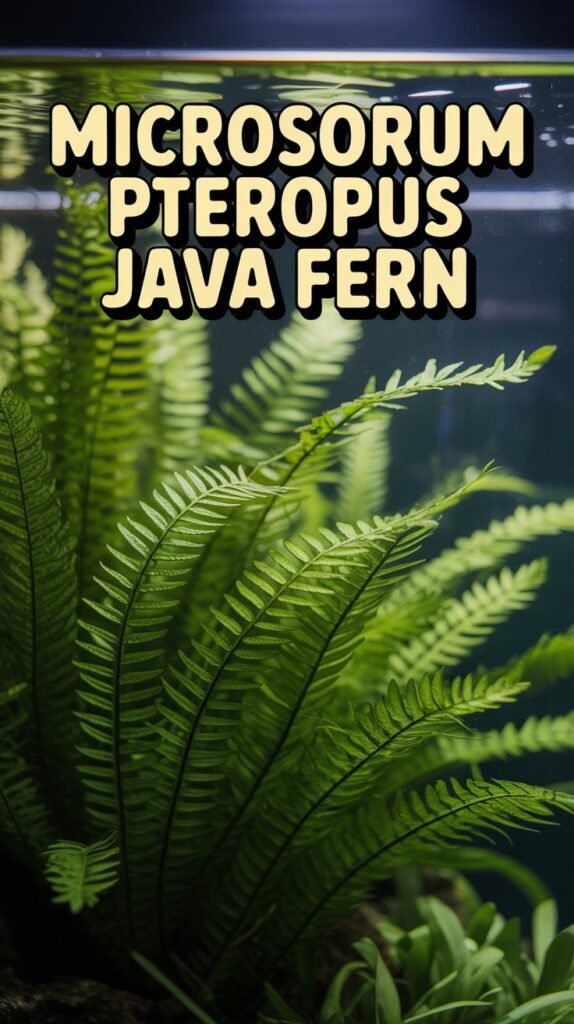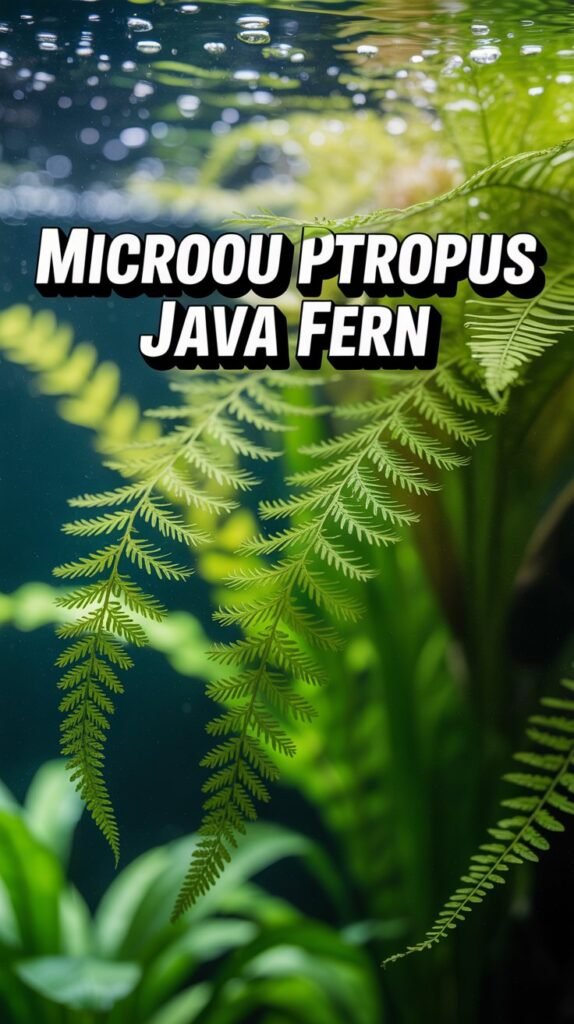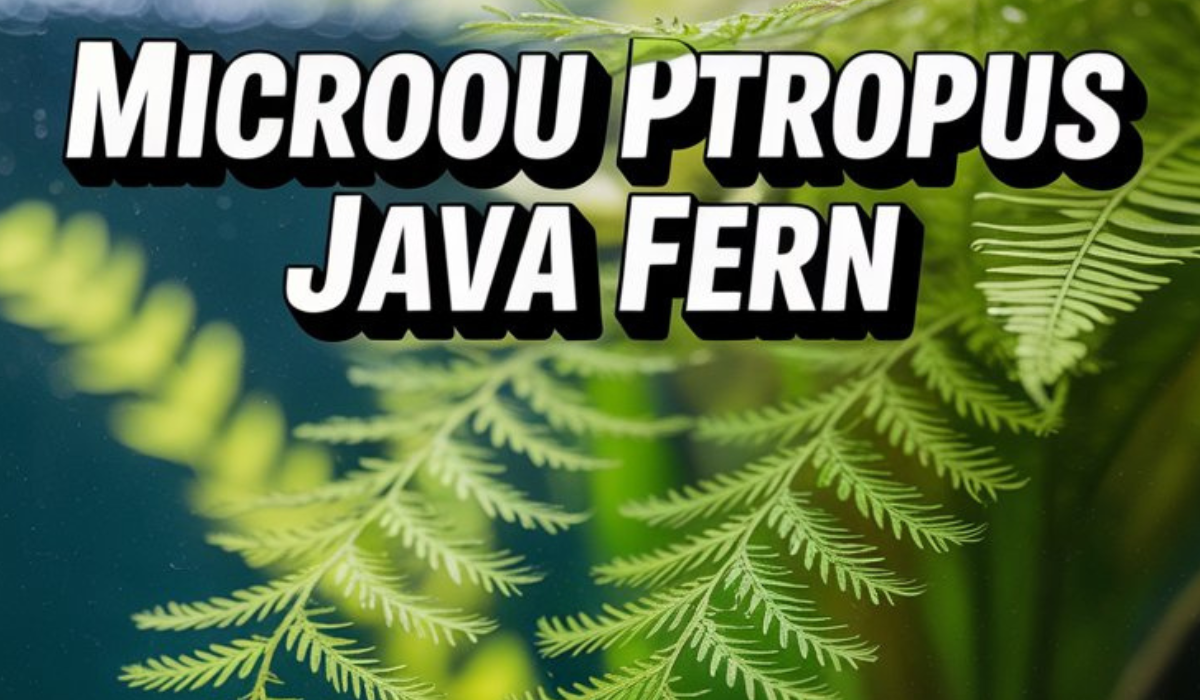Aquarium enthusiasts around the world admire Microsorum pteropus, commonly known as Java Fern, for its elegant appearance, hardiness, and low-maintenance nature. Whether you’re a beginner or a seasoned aquascaper, this aquatic plant adds a touch of natural beauty and tranquility to any tank. Its bright green leaves, distinctive textures, and ability to thrive in diverse conditions make it one of the most popular plants in freshwater aquariums.
In this comprehensive guide, we’ll explore everything you need to know about Microsorum pteropus (Java Fern) — from its origin, varieties, and care requirements, to propagation, aquascaping tips, and FAQs. By the end, you’ll have all the knowledge you need to successfully grow and maintain this stunning aquatic plant.
What Is Microsorum Pteropus (Java Fern)?
Microsorum pteropus, widely recognized as Java Fern, is an aquatic fern native to Southeast Asia — particularly Indonesia, Malaysia, and Thailand. It grows naturally in shaded riverbanks, waterfalls, and tropical forests, often attached to rocks or driftwood in shallow, slow-moving waters.
Java Fern belongs to the Polypodiaceae family. Its scientific name “Microsorum” means “small sori,” referring to the reproductive structures found on the underside of its leaves. The plant’s resilience and slow growth rate make it an ideal choice for both low-tech and high-tech aquariums.
Why Java Fern Is So Popular Among Aquarists

There are countless reasons why Microsorum pteropus is a staple in aquascaping:
- Low Maintenance: Java Fern is perfect for beginners. It doesn’t require special lighting, fertilizers, or CO₂ systems.
- Hardy and Adaptable: It tolerates a wide range of water conditions, temperatures, and lighting levels.
- Unique Growth Style: It attaches itself to hard surfaces like driftwood or rocks, making it an excellent feature plant for aquascaping layouts.
- Fish-Friendly: Its tough leaves are resistant to nibbling by most fish, including cichlids and goldfish.
- Aesthetic Appeal: With its lush green leaves and natural form, Java Fern adds texture and depth to aquariums of all sizes.
Appearance and Structure
The Microsorum pteropus plant has a distinctive and attractive appearance. It typically grows to a height of 8–13 inches (20–35 cm), depending on the variety and environment. Its leaves are leathery, vibrant green, and vary in shape — from narrow and pointed to wide and wavy.
The plant features a rhizome, a thick horizontal stem that anchors it to surfaces. Unlike many aquatic plants, Java Fern should never be buried in substrate. The rhizome must stay above the substrate to prevent rot, while the roots attach themselves naturally to rocks or wood.
The underside of the leaves may show small black spots — these are sporangia, which are part of the plant’s reproductive system. Many beginners mistake them for disease or algae, but they are a normal part of Java Fern’s growth.
Popular Varieties of Microsorum Pteropus (Java Fern)
Over the years, several unique varieties of Java Fern have been cultivated. Each has slightly different leaf shapes and growth characteristics, allowing aquascapers to mix and match for dynamic layouts.
1. Microsorum Pteropus ‘Narrow Leaf’
This variety features slender, elongated leaves that grow upright. It’s ideal for background planting and gives a vertical accent to aquascapes.
2. Microsorum Pteropus ‘Windelov’
Also known as “Lace Java Fern,” this variant has finely divided, lace-like leaf tips. It’s very decorative and adds intricate detail to planted tanks.
3. Microsorum Pteropus ‘Trident’
As the name suggests, the leaves of this variety split into multiple lobes resembling a trident. It’s a favorite among aquascapers for its unique texture and bushy appearance.
4. Microsorum Pteropus ‘Philippine’
This variant has slightly narrower leaves that are more upright and elegant, providing a clean, minimalistic look.
5. Microsorum Pteropus ‘Latifolia’
Characterized by broad, thick leaves, this variety creates a bold and lush presence in the aquarium.
Each variant of Java Fern retains the same care requirements, so you can easily grow multiple types in the same tank.
Ideal Tank Conditions for Java Fern

Java Fern is famously adaptable, but it still benefits from a stable, healthy environment. Here’s how to provide optimal conditions for thriving growth.
1. Tank Size
- Java Fern can be kept in almost any aquarium, from nano tanks (5 gallons) to large aquascapes.
- Because it grows slowly and doesn’t spread aggressively, it’s suitable for both small and large setups.
2. Water Parameters
- Temperature: 68°F–82°F (20°C–28°C)
- pH Level: 6.0–7.5 (neutral to slightly acidic)
- Hardness: Soft to moderately hard (3–8 dGH)
Java Fern adapts well to various conditions, but maintaining stable parameters will promote lush, healthy growth.
3. Lighting
- Low to medium lighting is ideal. High-intensity lighting can cause algae to grow on the leaves.
- Use indirect or diffused lighting for best results.
4. CO₂ and Fertilization
- CO₂ injection is optional; Java Fern can thrive in low-tech tanks without it.
- Occasional use of liquid fertilizers containing potassium and micronutrients can support leaf color and health.
How to Plant Microsorum Pteropus
Unlike rooted plants, Java Fern should never be buried in substrate. Instead, it attaches to hardscape materials.
Step-by-Step Planting Guide:
- Choose a rock, driftwood, or ornamental decoration.
- Place the rhizome (horizontal stem) on the surface.
- Use fishing line, thread, or super glue gel to attach the plant securely.
- After a few weeks, the roots will naturally anchor themselves.
- Once attached, you can remove any binding material.
By attaching Java Fern to hardscape, you can create a natural, forest-like aesthetic in your tank.
Growth and Maintenance Tips
Java Fern is a slow grower, typically producing one or two new leaves per month. However, with proper care, it can live for years and become the centerpiece of your aquascape.
Here are a few maintenance tips to keep your Microsorum pteropus healthy:
- Avoid burying the rhizome. This is the most common mistake — it leads to rot and plant death.
- Trim dead or damaged leaves regularly to encourage new growth.
- Clean algae gently from leaves using a soft brush or by reducing excess light.
- Perform regular water changes (20–30% weekly) to maintain clean water conditions.
- Use nutrient supplements occasionally if the leaves appear pale or transparent.
Common Problems and Solutions
Even though Java Fern is hardy, some issues may arise in certain setups. Let’s look at common problems and their fixes:
1. Java Fern Melt
- Symptoms: Leaves turn brown or black and fall apart.
- Causes: Sudden change in water conditions, burying the rhizome, or new tank setup.
- Solution: Remove decayed leaves; allow the rhizome to regrow new ones. Be patient — new shoots often appear after a few weeks.
2. Algae Growth
- Symptoms: Green or black algae forming on leaves.
- Causes: Too much light or excess nutrients.
- Solution: Reduce lighting intensity and duration; introduce algae eaters like Amano shrimp or Nerite snails.
3. Yellowing Leaves
- Symptoms: Pale, yellowish leaves.
- Causes: Nutrient deficiency (especially potassium or iron).
- Solution: Use a balanced liquid fertilizer or root tabs near the base of the plant.
Propagation of Microsorum Pteropus

One of the easiest aspects of Java Fern is its propagation process. The plant reproduces through rhizome division and plantlets.
1. Rhizome Division
- Cut the rhizome into two or more sections, ensuring each has leaves and roots.
- Attach each section to a new surface — both will grow independently.
2. Plantlet Formation
- Small baby ferns (plantlets) form on the underside or tips of older leaves.
- When these plantlets grow roots and a few small leaves, gently separate them and attach them elsewhere.
Propagation is slow but rewarding, allowing you to expand your aquascape naturally without buying new plants.
Aquascaping with Java Fern
Java Fern is a favorite among aquascapers for its versatility and adaptability. It works beautifully in various layouts, including natural, jungle, and biotope-style aquariums.
Here are some aquascaping ideas:
- Foreground Accents: Use smaller varieties like ‘Trident’ or ‘Windelov’ in the mid-ground for texture.
- Background Planting: Tall, narrow-leaf varieties provide a lush green backdrop.
- Epiphytic Displays: Attach Java Fern to driftwood, rocks, or decorative ornaments for a natural forest-floor look.
- Combination Planting: Pair with Anubias, Bucephalandra, or Cryptocoryne for contrast in texture and color.
Because it doesn’t require substrate planting, Java Fern allows great creative freedom in designing your aquascape.
Compatibility with Tankmates
Java Fern is compatible with nearly all freshwater aquarium inhabitants. Its tough, bitter-tasting leaves discourage most herbivorous fish from nibbling.
Ideal Tankmates:
- Guppies
- Tetras
- Bettas
- Angelfish
- Gouramis
- Shrimp (especially Amano and Cherry Shrimp)
- Snails (Nerite, Mystery)
It’s even suitable for semi-aggressive fish tanks, as the leaves provide cover and resting spots.
Avoid with:
- Large, destructive cichlids that might uproot plants (though they rarely eat it).
- Goldfish may sometimes tear leaves but won’t usually consume them.
Benefits of Having Java Fern in Your Aquarium
Adding Microsorum pteropus to your aquarium doesn’t just enhance its beauty — it also contributes to a healthier aquatic ecosystem.
- Improves Water Quality: Absorbs nitrates and helps control waste levels.
- Provides Shelter: Offers hiding spots for small fish and shrimp.
- Algae Prevention: Competes with algae for nutrients.
- Oxygenation: Contributes to oxygen exchange through photosynthesis.
- Natural Filtration: Helps stabilize biological balance in aquariums.
Java Fern in Different Aquarium Styles
Low-Tech Tanks
Java Fern thrives without CO₂ or intense light, making it perfect for low-maintenance tanks. Combine it with hardy species like Anubias and Java Moss for a lush, beginner-friendly aquascape.
High-Tech Aquascapes
While it doesn’t require CO₂, it can still flourish under high-tech setups. The additional nutrients and light encourage denser, faster growth and vibrant coloration.
Biotope Aquariums
In Southeast Asian-themed biotopes, Java Fern is essential. Pair it with driftwood, smooth stones, and soft lighting to recreate natural riverbank environments.
Myths About Microsorum Pteropus
There are several misconceptions about Java Fern care. Let’s clear them up:
- Myth 1: Java Fern must be planted in substrate.
❌ Fact: The rhizome must stay above substrate; burying it leads to rot. - Myth 2: It can’t grow without CO₂.
❌ Fact: Java Fern grows perfectly well in non-CO₂ tanks. - Myth 3: Black spots mean disease.
❌ Fact: Those are reproductive spores, not signs of decay.
Final Thoughts
Microsorum pteropus (Java Fern) is one of the most forgiving, beautiful, and versatile aquarium plants available. Its rich green leaves, resilience, and easy propagation make it a cornerstone in the world of aquascaping. Whether you’re crafting a lush jungle theme or a simple, minimalist setup, Java Fern adapts beautifully.
With proper care — stable water conditions, moderate lighting, and regular maintenance — Java Fern will reward you with years of growth and natural charm. It’s not just a plant; it’s a living work of art that enhances both the aesthetic and ecological balance of your aquarium.
FAQs About Microsorum Pteropus (Java Fern)
1. Is Java Fern suitable for beginners?
Yes. It’s one of the best beginner plants because it’s hardy, slow-growing, and thrives in low-light aquariums.
2. Can Java Fern grow without substrate?
Absolutely. It grows best when attached to driftwood, stones, or decorations — not buried in substrate.
3. Why is my Java Fern turning brown or black?
This could be due to rhizome rot, sudden changes in water parameters, or nutrient deficiency. Trim dead leaves and ensure proper conditions.
4. How fast does Java Fern grow?
It’s a slow grower, usually producing new leaves every few weeks. Growth may speed up under higher light and CO₂.
5. Can Java Fern be grown with other plants?
Yes. It pairs beautifully with other low-light plants like Anubias, Mosses, and Cryptocorynes.
6. Do fish eat Java Fern?
Most fish avoid it due to its tough, bitter leaves. It’s safe even in cichlid or goldfish tanks.
7. Can I propagate Java Fern easily?
Yes, by dividing the rhizome or separating baby plantlets that grow on the leaves.
8. What lighting is best for Java Fern?
Low to moderate light is ideal. Too much light encourages algae.
9. Can Java Fern survive in saltwater tanks?
No, it’s strictly a freshwater species and will not tolerate saltwater.
10. How long can Java Fern live?
With proper care, Java Fern can live indefinitely, continually producing new growth and plantlets over the years.

